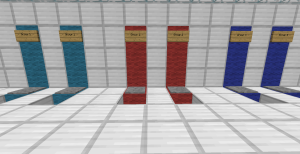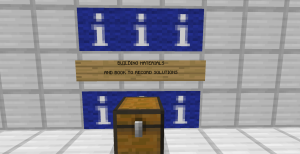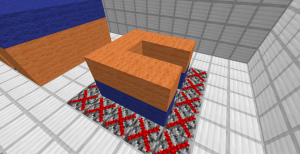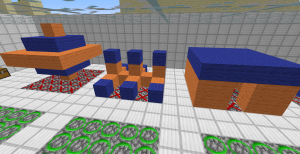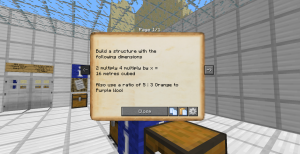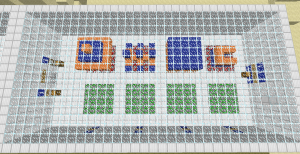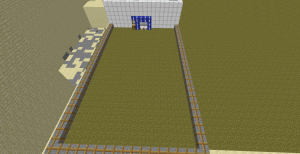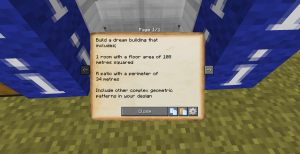Home » Lesson
Category Archives: Lesson
3D Measurement – GameTIME
Why not add a little competition and game play to add some excitement to your 3D Geometry unit. I have constructed a game to challenge students to think and apply their knowledge through a series of different zones. Zones that get them to measure, record and build their own designs.
Learning Goals (all structures/concepts could be modified depending on STUDENT Level – see below)
- construct a three-dimensional figure from a picture or model of the figure, using connecting cubes (gr. 4)
- Measure, and record the perimeter and area of polygons (gr.4)
- build three-dimensional models using connecting cubes, given isometric sketches or different views (i.e., top, side, front) of the structure (gr.6)
- construct a rectangle, a square, a triangle, and a parallelogram, using a variety of tools given the area and/or perimeter (gr.6)
***NOTE could be adapted for a variety of Grade Levels by changing the complexity of the measurements provided***
Lesson Format : Game Based
- Start with recreating examples (isometric sketches or example builds). Students need to fill out a book with measurements of each of the provided structures (book and quill) Teacher checks the books for communication and accuracy to determine advancement.
- Build to match measurements (students are provided materials and must build structures that meet measurement criteria)
- Free Create and Record (allow students build their own design in creative mode) Encourage more complex geometric shapes)
Bonus Extension – screen shot, label and explain each stage (App Smashing) Use of PowerPoint, or OneNote to capture builds and further explain student thinking.
CONSIDERATIONS
1. Time Limit
- Instead of taking the time to check student work as they advance – you could use time segments to control advancement of Levels (open doors to next stage after set amount of time)
- Students do not need to move on, but could (need to self-assess – how well have I completed this stage as it will be scored at a later time)
- The ability to go back could be useful to check work, or return for the Bonus Round
2. Individual vs. Partner Builds
- add Learning Skills and peer support with cooperative builds
- Culminating activity vs. Unit Introduction
ASSESSMENT
- Teacher conference, or Peer feedback (students check)
- Use of gems or items to provide feedback of each stage (Achievements earned)
- Could create a similar with table as below with students based on Success Criteria
I’m using this as a three day competition. Students responses and builds will be recorded and marked daily. The next class they will return to the same building areas, and find their rewards that reflect their work. They will be instructed to keep it in their chests, but can look to get feedback. After Day 3 they will use the supplies to get a head start in an Adventure Survival Challenge.
| Day 1 | Day 2 | Day 3 | |
| Stage One | Helmet & Boots | Shovel | Food |
| Stage Two | Leggings | Pick Axe | Bow |
| Stage Three | Chest Plate | Sword | Arrows |
***Quality of Items will look different based on Accuracy/Quality of stage work***
Choose Your Own Adventure – Coming to a Map Near You!
As a student I was reluctant as a reader, and even more reluctant as a writer. I could never come up with an idea, and lacked the creativity to come up with settings (or so I thought).
If only I had a game that I was passionate about – that could provide me a new setting every time I started a New World –Enter Stage Left – Minecraft and endless amounts of settings included!
One of the draws that I find excites my students about Minecraft is the random world that is presented before them. With every new game you are presented with a new Adventure, and layout that begs to be explored.
This lead me to my next Writing Idea – A throw back to one of my own favourite entertaining reads – Choose Your Own Adventure Series
This year I have a large group of boys who do not like to write Fiction – but when I mentioned how MinecraftEdu could be the backdrop of our ideas – students were communicating all the different ways they could write – and use Redstone to lead the reader through a variety of different plots. And our Interactive Choose Your Own Adventures were born. Read on to see our focus and steps to direct our writing.
Our Learning Goals
Writing (Six Traits)
To focus on word choice, sentence fluency – identify elements in their writing that need improvement, (based on Teacher observations -six traits may vary based on class/student), with a focus on depth of content
Reading (Inference)
To provide an environment that challenges the reader to react and make choices based on text and prior experiences
Introduction
1. In a class discussion, we outlined what makes us an Adventure Genre
- What are key characteristics of Adventure Narratives (Stories)
a. Main character (Protagonist) shares the story
b. Goes on a quest or journey
c. Faced with a variety of challenges or conflicts
d. Secondary characters offer support through dialogue or action
e.Concludes when Protagonist succeeds or accomplishes main goal
f. Etc. based on class idea2. Also, asked – How does a Choose your Own Adventure differ than a typical Novel
a. Often is written in second person and reader takes on role of adventurer
b. Choice for two or more paths are provided
c. Settings could provide clues (reader needs to use make inferences
d. Variety of endings (not all with success)3. How could Minecraft be a tool to help share a Choose your Own Adventure?
- A variety of settings already exist (different biomes)
- Easy to build pathways, or door choices
- A variety of effects can be added to players based on actions (potions, traps, discoveries)
- Can add text using signs, info and command blocks
Used a Guide as an Example
- Pre-built “Chose your Own Adventure” to read aloud with the class and make choices collectively (work in inference to how we can make an educated decision) – student justify choices (using support from the text, setting. and their own knowledge)
- What was effective about the example (direct to the text, in combination with the setting to share a Narrative – helps visualize)
- How could we have improve this text to help, engage, inform the reader? (what changes or alterations could you make to make it a more entertaining story – focus in on Elements of a story)
Writing – Planning
- Use a story map to help sketch out ideas (beginning – middle choices – conclusions) Smart Ideas, or Linoit online
- Idea, Setting(s), Characters, Plot Decisions, Possible outcomes
Writing – Building
- In game to locate, develop and build settings
- Adding in Pathways to direct reader
- Writing – using signs, info blocks, and command blocks
- Extension – use of redstone to add in secret switches to open new locations
Writing – Revisions
- Is the story easy to follow (paths and choices – both through text and visuals)
- Does it make sense?
- How does the reader make transitions -did they use text to communicate results or just effects on player? (I believe both are important – often leave the reader confused as lack of description)
Writing – Editing
- Errors should be corrected and fixed
- Some signs, blocks will need to be broken and re-written as cannot just edit individual words, or add in missing punctuation.
Presenting and Sharing Stories
- share as a class, small group.
- Might need to add in do not build blocks or change game mode. This would prevent accidently breakage of signs or story elements.
- Peers assess how the writing challenge them to use info from the text and prior knowledge to make decisions.
Assessment – SUCCESS CRITERIA **TAKE SCREENSHOTS THAT DEMONSTRATE THE FOLLOWING** use F2 button to take screen shots
- Narrative is engaging and memorable
- Smooth transitions, strong lead and satisfying conclusions
- Phrasing and word use is interesting, descriptive and unique
- Sentences are well build, with strong varied structure
- Only the pickiest editors will spot the remaining errors
- Presentation – clear pathways and settings add to the story
Resources
https://www.youtube.com/watch?v=uWTKlfynSuo – video overview of how to create a story pathway using command blocks. I first heard the idea about building a story path via twitter from Adam Clarke
Graphic Organizers
- Lino (online)
- Popplet (online)
- Smart Ideas (Smart Technologies)
- Smart Art (Word)
THIS WEEK STUDENTS ARE FINISHING THEIR WRITING AND WE LOOK FORWARD TO SHARING OUR STORIES AS A CLASS (and I through screenshots here on this blog) – Stay tuned
A Perfect Village – Ready – Set – GO?
For a Guided Math Session, I have decided to offer the following game-based experience for students. I welcome all feedback (before I launch), and will provide a follow-up comment once the lesson has been completed by a group. Feel free to test with your students, and let me know how it goes.
A partner challenge to compete in this four day challenge. Who will build the perfect village? With the help of one of my students we have used command blocks to set up a Store to manage the Survival world. Important to note – no supplies can be obtained by students, and they must use the following allowances to purchase all supplies;
Stage 1 $1000 Mapping it out
Stage 2 $10 000 Improving and building a sustainable community
Stage 3 $100000. Add in new expensive blocks (diamonds, redstone, pistons?)
Stage 4 Trade Market
Must complete each stage before moving on; Teacher Conference Required after each stage
STAGE 1 Mapping it out! Only show dimensions and fractions and students are required to mark out each area using the following;
- demonstrate and explain the concept of equivalent fractions, using concrete materials (grade 5)
- solve problems requiring the estimation and calculation of perimeters and areas of rectangles
- demonstrate an understanding of simple multiplicative relationships involving whole-number rates, through investigation using concrete materials
Fractions to plan area. Amount of land? 30 x 30?
- Houses. 1/5
- Parks, and Green Space 2/20
- Farm – food production 1/3
- Roadways 3/10
- Stores 1/15
I’ve decide to provide some direction to the students by providing them an initial worksheet to help them plan.
The Perfect Village Challenge – I decided to share the worksheet after I test drove the activity with a few students. And I learned, in order for them to successfully map it out they needed to roughly sketch out their ideas first. One student, shared this and said “and not sure how many would do it without the guidance, and it would be too confusing without it.”
I will also share the following prompts with them as well;
- Make a sketch to map out your design on provided grid paper
- Make a shopping list of what block, supplies before you enter the game
- Must stay within budget ($1000) – The $1 sale
- Map out you area by using the following blocks to map out the ground ; Wood – House(s) Area, Parks/Green space – Grass, Farm – Dirt, Roadways – Gravel, and Stores – Cobblestone
- Need to survive (don’t forget to buy some food) (steak $5, bread $2, and apples $1)
- Set your Home block – will be helpful to teleport back to your town if you need to re-spawn (Give one to each student)
STAGE 2 Improving & building a sustainable Community (encouraged students to account for their budget as they spend)
- represent relationships using unit rates
- add and subtract decimal numbers to thousandths
New Items available for purchase. Government grants you $10 000 to improve your town. You may purchase animals, tools (bucket), and water to help you build a sustainable community. Also, you can improve the look by using many new decorative blocks. Including, but not limited to; doors, glass, stairs, and metals. Check price list for availability.
(glass blocks, Stone, iron, different planks, pig, cow, chicken, seeds, samplings, coal, colour wool? 2 stores – Costco (Bulk) vs Sobeys (more choice but per 1 item) 3 for $20 or 1 for $10
- Ask the Question of where next – chance to use the chat – What items are you missing that you would pay more for?
STAGE 3 Add Functions and Quality
- solve problems involving the calculation of unit rates
- solve multi-step problems arising from real-life contexts and involving whole numbers and decimals
The Wealth Grant has rewarded you $100 000 . You must spend wisely to get resources that will help your town function and make it one of the best villages in the county. Establish your goals and search the new items for purchase. Could you benefit from more rare items that will improve the automation of your town (redstone, pistons, and the might powerful command block)
- Offer items based off the suggestion and votes at the end of Stage 2
(redstone, redstone-torch pressure plates, pistons, glowstone, diamond, gold, emerald??? ) $1000 items
Day 4 (Game Extension – Time permitting) Money has run out – Stay calm and Trade On!
- demonstrate an understanding of rate as a comparison, or ratio, of two measurements with different units (grade 7)
What do you need to make more complex creations? (recipes – what are you missing – establishing value) Is one diamond block to 10 blocks of Iron – how do you justify? It is important to consider; What do you need (recipes) ? What can you offer? (appropriate value)
- Also, a chance to see each town and what they have been able to create.
Assessment
Tracking Student Learning – Conferencing and the use of OneNote
- Teacher takes screen shots and takes notes during conferences (ongoing)
- Guiding Questions
– How did you determine how much land each town component required?
– Did you estimate how many blocks you would need for each area? Calculate how many blocks you needed to purchase?
– What was most challenging about managing your budget accurately?
– How did you manage your budget? Trial and Error vs. Systematic approach
– Were you able to use unit rate to help you when purchasing in large quantities?
– Was it possible to establish a fair trading market?
Thanks for reading our Game-based lesson, and we look forward to sharing how it plays out with the students (or share your experience if you decide to test it out).

